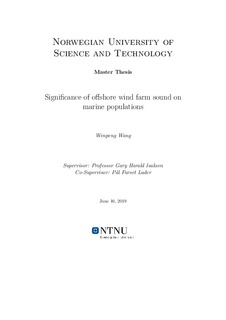| dc.description.abstract | Offshore wind energy is one of the most important renewable energy globally. Currently, Europe is leading both in capacity and technology exports. Although Norway has significant wind resources, the development of offshore wind farms (OWF) has been limited to-date, especially when compared with Denmark and the UK. Fifteen zones in Norway are considered suitable for offshore wind farm development, with an estimated overall capacity from 4,600 to 12,600 MW. This work seeks to understand the character of the anthropogenic sound produced during offshore wind farm life-cycle, including the seismic survey phase, the construction phase and the operation phase. During each of these phases sound is introduced into the environment. This work also discusses potential negative effects on marine life.
In the thesis, sound emissions are modeled at five sites. These sites are considered “Category A sites” (most suitable sites) for OWF’s development by Norges Vassdrags og Energidirektorat (NVE) The sites are: Sandskallen (Finnmark), Utsira Nord (near Karmøy/Haugesund), Frøyagrunnene (Sogn og Fjordane), and Sørlige Nordsjø I and II (two sites close to each other in North Sea).
Acoustic modelling was based on ray theory in addition to complement at acoustic boundaries. Results are provided for the geophysical survey phase, construction phase and operation phase of the offshore wind farm life-cycle. The decommissioning phase has not been modeled. The acoustic models served as input for assessing if and how sound from offshore windfarms may affect marine mammals and fish species.
Adverse impacts to fish and marine mammals are limited to zones very close to the sound sources in the cases studied. During the survey and construction phases any potential risks (although small) can be further mitigated by marine mammal observers and fishery liaisons. As such, the development of offshore wind farms is not considered a significant threat to Norwegian fisheries or marine mammal populations off Norway’s coast.
As an example, using Sandskallen offshore Finnmark in August, and starting with a source pressure level (referenced by convention as 1 meter from the sound source) of 212 dB re 1 μPa and sound exposure level (for marine fauna) at 192 dB re 1μPa2s, then SEL 180 dB re 1μPa2s is present less than 5 meters from the sound source. Likewise, at 100 meters from the sound source the sound exposure level is down to 155 dB re 1μPa2s。
Seasonal variations have also been found from the results. Impact area is most limited in August, which represents ocean environment in summer, while results in March (Spring) and December (Winter) are similar.
Finally, the thesis lists knowledge gaps in the research, e.g., particle motion measurements and its potential impact on marine life and recommendations about possible mitigation measures during operations. | |
